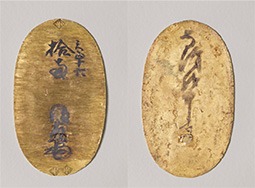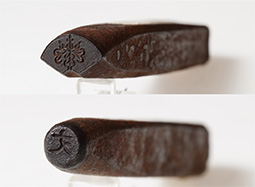October 2022
- English
- 日本語
Oban, Japan’s Giant Gold Coins

Tensho Naga Oban (approximately 17.5 cm x 10 cm) 
A Tensho Oban, front side at left, reverse side at right 
Seal stamps used to ensure the quality of the currency

In this article we introduce oban, the large gold coins once made by Toyotomi Hideyoshi, who unified Japan, and by the Edo shogunate.

Large oval-shaped gold coins known as oban were made from the second half of the 16th century until the 19th century. They measured from between 14 to 17 cm in length. These coins were not for general circulation, but were instead made on a limited basis by Toyotomi Hideyoshi (1537–1598)* and the Edo Shogunate as awards, gifts, or other ceremonial items. The coins fascinate the viewer today with their beauty; with line patterns, seal imprints, black-ink lettering and other unique features on the surface of each coin that accentuate the shining gold.
There are six varieties of oban, broadly divided by era.** Genuine examples of these coins are on display at the Currency Museum in Tokyo, located in the Institute for Monetary and Economic Studies at the Bank of Japan. Sekiguchi Kaori, the Chief Curator of the museum, says, “Our museum exhibits all six varieties of oban, including the Tensho Naga Oban***, one of the world’s largest gold coins with a consistent length of about 17.5 cm. It is rare to see such a collection on display together. Ordinary people at the time would not have been able to see them, because all of these were highly expensive coins mainly used as a gift.”
Gold coins were first minted in Japan around the middle of the 8th century, but they would not become a form of currency until much later. Until the 16th century, mainly gold dust was used for large transactions between merchants or as awards to samurai for their military achievements. Full-scale manufacturing of gold and silver coins began in the early 16th century, once silver mines mainly in west Japan and gold mines in east Japan were successively discovered and developed. While the feudal lords were fighting over the mines, mining and refining techniques improved and spread, and feudal lords from around Japan all began to manufacture coins in their territories.
During this time, Toyotomi Hideyoshi had Goto Tokujo, the fifth-generation head of the Goto family which had been making sword fittings as a family business for generations, create the Tensho Oban in 1588. This coin determined the format for later oban coins. These coins were made by pounding gold and silver together to form an alloy, and were larger than a typical smartphone today, with a length of around 17 cm and a width of around 10 cm. They weighed around 165 grams, with a gold content of between 70% and 76%.
Later, in 1603, Tokugawa Ieyasu (1543–1616) established the shogunate and took direct control of the Sado Gold Mine (in present-day Niigata Prefecture) and the Izu Gold Mine (in present-day Shizuoka Prefecture), the major gold mines at the time, and established direct control over the manufacturing of gold coins. The format of the Tensho Oban coins was followed and manufacturing was continued by the same Goto family.

There are characters written on the face of the oban in black ink, denoting the weight, the Goto family name, and kao (written seal mark), which acted as the signature of the head of the Goto family at the time. There is also a paulownia tree crest stamped on the coins. Sekiguchi says, “The Goto family manufactured coins at the oban-za, or oban mint, specially set up when the Edo Shogunate ordered the manufacturing of oban. The weight and gold content of the coins changed over time, but manufacturing was always entrusted to the Goto family. Having the coins manufactured by the Goto family was a guarantee of quality.”
The Edo Shogunate established a three currency system of gold, silver, and copper coins as currency. Oban were mainly offered as gifts and not used for ordinary purchases. The koban, a miniaturized version of the oban that could be mass-produced without ink writing, was then introduced. One koban coin had the value of one ryo (see here). However, when the Meiji government was established in 1868, Japan began its journey on the road to modernization and the oban and its role ended.

* A feudal lord who unified the country. According to some accounts he was born in 1536.
** Tensho Oban (1588), Keicho Oban (1601), Genroku Oban (1695), Kyoho Oban (1725), Tenpo Oban (1838), and Man’en Oban (1860)
*** A type of Tensho Oban, with the very long and large coins being called Tensho Naga Oban

